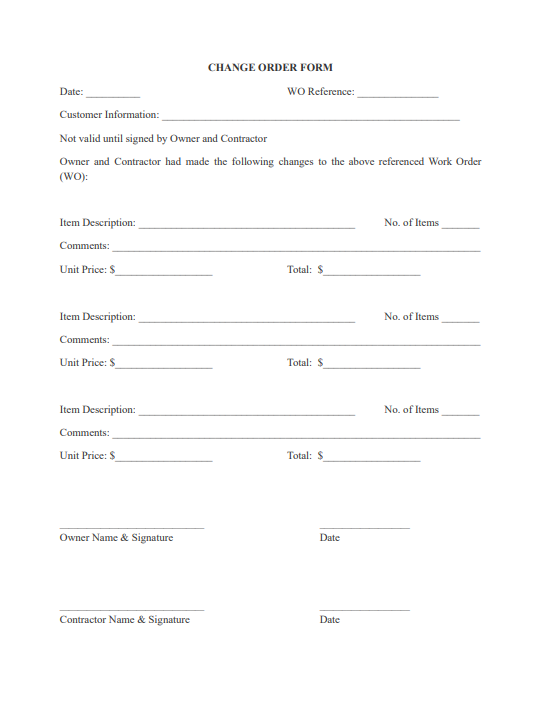What information is each section asking for?
At the top of your G701 form, you’ll see the section asking for project information.
- “Project”: the name of the project and the address or parcel number.
- “Contract for”: descriptions of the work, materials, or services you are providing to the project, including the date that the contract began.
- “Change order information”: the change order number and the date of the change order. For example, if this is the first change order on this contract, put down 001.
- “Owner”: the name and address of the project owner.
- “Architect”: the name and address of the project architect. If an architect is not part of the project, this might be the GC or project manager.
- “Contractor”: your name and address under “contractor.”
The next section of the AIA G701 Change Order form begins with “THE CONTRACT IS CHANGED AS FOLLOWS.” This is where you should describe all of the changes to the original contract. Make sure to include all of the details of the proposed changes, and the cost of each change. It’s important to be specific in case a payment dispute arises later concerning the details of the work
The next section will provide all of the previous accounting values, and how the change in work will affect the contract price. For the purpose of this video, we’ll assume you’re using lump sum.
- “The original Contract Sum/GMP”: the original contract amount for the work. This number will be the same throughout the project, no matter how many change orders you write.
- “Net change by previously authorized Change Orders”: if this is the first change order on the project, this value will be 0. If it’s the second change order or after, then this field will be the total value of the previous changes. This can be either a positive or negative change, as some change orders are deductive change orders.
- “The contract sum prior to this Change Order”: to get the right figure, simply add the two lines above this one. This figure is the total of the original contract sum and the net change by previously authorized change orders.
- “The Contract Sum will be increased, decreased, or unchanged by this Change Order in the amount of ___”: This is where the total cost of the current change order is written. This should match the price that the owner or architect agreed upon for the change.
- “The new Contract Sum/GMP including this change order”: add up the two previous lines, or subtract them if the change order decreases costs. This is the new total contract sum after accounting for the current change order.
- “Contract Time will be increased, decreased, or unchanged by ____ days”: add how the change order will affect the performance time, in the number of days.
- “New date of Substantial Completion”: once you determine the number of days that will be affected by the change order, add or subtract that from your contract’s date of substantial completion. This is the new date you expect to finish the work by.
Who should sign the AIA G701 Change Order form?
- Finally, get it signed. A change order is basically an amendment to the original contract, so it should be signed by all of the relevant parties. It requires signatures from the contractor agreeing to the changes, and the owner and architect ordering the changes.
Also, for record-keeping purposes, the AIA G701 should also be printed out and signed three times. That way each party has an original, executed copy to clarify any issue that can potentially come up later on in the project.
Related Forms:
Other Forms
- Affidavit Forms
- Assignment Forms
- Attorney Forms
- Bankruptcy Forms
- Bill of Sales Forms
- Borrow, Lend & Collection Forms
- Business Forms
- Confidentially Forms
- Contract Forms
- Copyright Forms
- Corporation Forms
- Credit Form
- Declaration Form
- Deed Forms
- Divorce Forms
- Employment Forms
- Entertainment Contract Forms
- Family Law Forms
- Free Will Forms
- Government Form
- Health Care Forms
- Homestead Form
- Indemnity Agreement Form
- Intellectual Property Forms
- Internet Forms
- Landlord and Tenant Forms
- Lease and Rental Forms
- Letter Forms
- Limited Liability Co. Form
- Non-Compete Forms
- Non-Disclosure Forms
- Notice Forms
- Parental Permission Forms
- Partnership Forms
- Power of Attorney Forms
- Premarital Forms
- Promissory Notes
- Real State Forms
- Release Forms
- Sale & Purchase Forms
- Technology Forms
- Trademarks Forms
- UCC Forms


